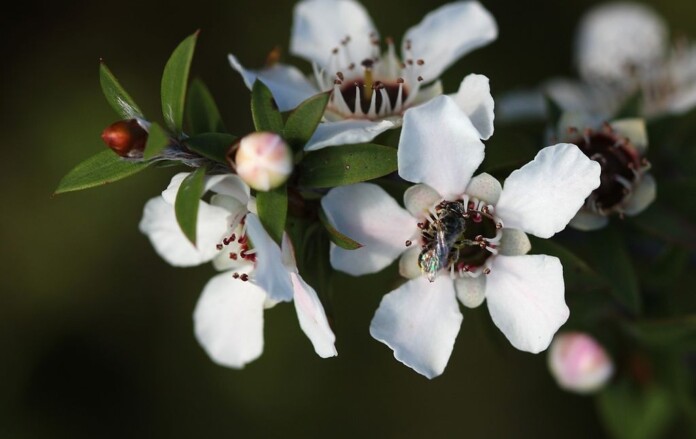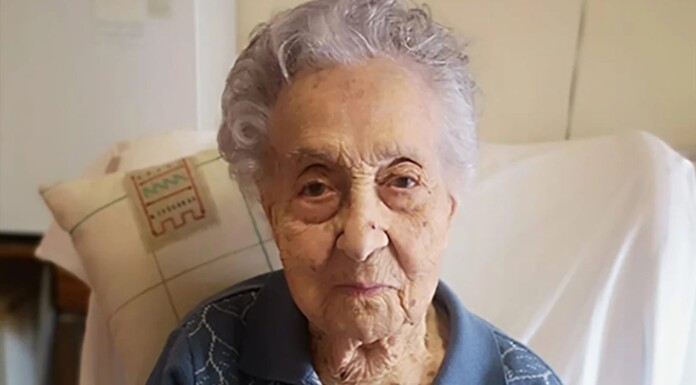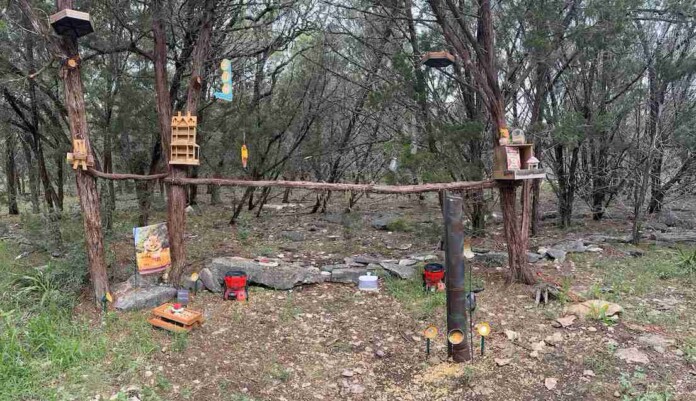Happy 51st Birthday to the simply hilarious Dave Chappelle. One of the greatest millennial comics, Chappelle was called a genius during his early explosion of fame on basic cable’s Comedy Central with his sketch comedy show, Chappelle’s Show. Born in Washington D.C., Chappelle has won 6 Emmys and 4 Grammys, along with the prestigious Mark Twain Prize for American Humor. CHECK Out Dave’s story… (1973)
Plan a Trip to Alaska and Stay in These Classic Airplanes Converted into Luxury Accommodations (LOOK)

A flying instructor in Alaska, has taken on a second gig as manager of an “airplane amusement park” complete with luxury accommodations built out of old, decommissioned aircraft.
John Kotwicki says there’s little red tape interfering with getting old airplanes up to his flight school and converting them into Airbnbs to use as a base to explore southern Alaska’s incredible natural scenery.
He’s in the process of converting a third aircraft, while also building a cabin into the top of a runway control tower for unparalleled stargazing, a frisbee golf course, volleyball court, and authentic aircraft hanger to display the parts ripped out of the old airplanes.
Kotwicki runs the pilot school FLY8MA, but never wanted to go into commercial aviation because of how “boring” it was, remarking that driving for Uber is more exciting because you can talk to the passengers.
It was after a trip to the south-central area of Alaska that he fell in love with the state’s wilderness and wanted to move that way. His plan was to develop his own runway and facilities for flying, but it quickly became so much more, as he had to add cottages for the students, and then cottages for the tourists who came via word of mouth from the students to experience the remote southern Alaska terrain.
“And then, like, let’s one up that,” Kotwicki told CNN. “It would be cool if we got an old airplane to turn into a house. Let’s make it really nice and put a Jacuzzi on the wing and a barbecue grill. Let’s get two more and have three of them.”


Starting with a US-built 1950s DC-6, known as the C-118 Liftmaster in the Air Force, Kotwicki then set to work on a larger DC-9, and then a Boeing 727.
Featuring heated floors, heated towel racks, a fully functioning kitchen, and a firepit/BBQ on the wing which is also a deck, the DC-6 sleeps up to 4 and runs $441 per night.
The DC-9 will have a spa/sauna as well, and be able to sleep 6, while the 727 will be more like a lodge space, with a big dining hall, and a rooftop deck on the tailwing.
ALSO CHECK OUT: Spend the Night in a Giant Flower Pot – AirBnb is Funding The Most Off-Beat Lodgings
BUILD IT AND THEY WILL COME: Man Builds Cozy Treehouse to Post on AirBnB and Earns Enough to Quit His Job (LOOK)
“It’s fun, whether it’s grown adults just in awe of the place, or it’s kids running up and down the whole length of the airplane, going crazy and running to the cockpit,” Kotwicki said. “It’s frustrating and stressful and overwhelming and expensive to do these things – but it’s rewarding.”


The property is all owned by Kotwicki and stretches out around 100 acres which he says has no zoning limitations whatsoever. The hardest part is finding the decommissioned planes to convert, which takes about 9 months of cold calling aviation acquaintances, and then transporting it up to Alaska on the highways.
Once there, the dampness and cold make it very difficult to maintain the planes, which are thin, light, and have to be specially insulated to keep the heat in for the guests. He admits it would have been a lot easier to do this sort of thing in Arizona, but the beauty and freedom of Alaska outweigh the maintenance requirements.
MORE CREATIVE AIRBNBS: Couple Builds Airbnb in Just 10 Days – The Stunning Airship is Now a Top-Requested Property
There are grizzly bear viewing spots, incredible fishing opportunities, a cross-country ski trail, the Northern Lights, and so much more surrounding the airstrip.
SHARE This Amazing Opportunity For a Getaway In Nature…
First-Ever Coral Crossbreeding Hopes to Mimic the Resilience of an ‘Invincible’ Reef in Honduras
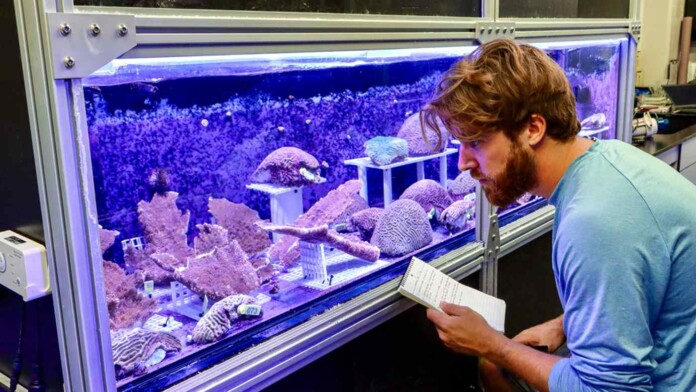
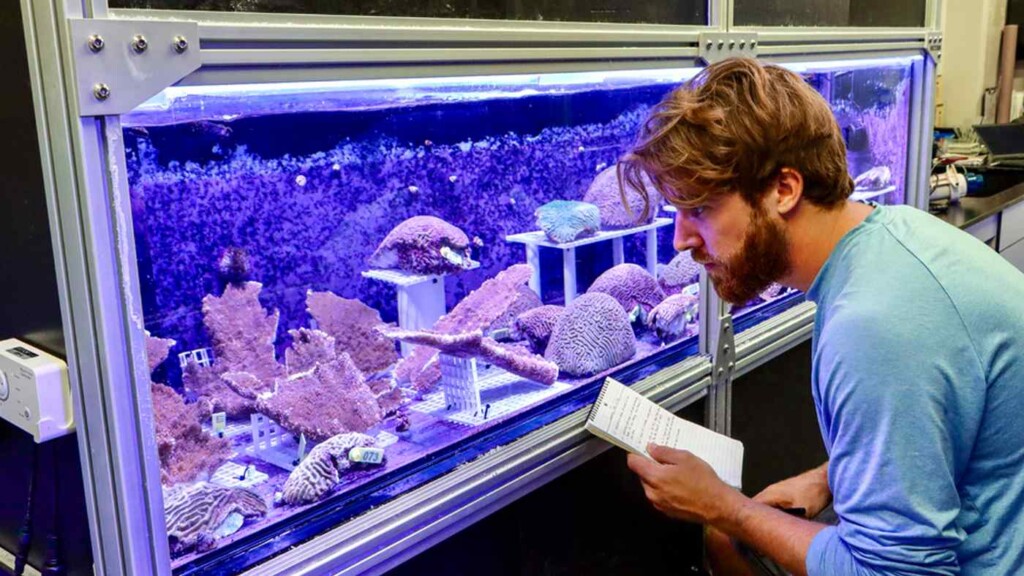
Mere feet under the waters off the coast of the Honduran city of Tela lies a coral reef that has the entire marine scientific community excited.
The reef of Tela Bay should be dead if anything we know about coral reefs is true. The harms it faces are manifold, from warm waters to boat traffic to agricultural runoff and murky water.
Not only can the Tela reef survive these hazards, it thrives—as no other reef in the Caribbean thrives. On any given day, live coral cover in Tela is around 65%, almost four times more than the average for the Caribbean (18%).
Scientists are now working hard and fast to try and solve the mystery of why the Tela Reef seems partially invincible, and whether its secret sauce can be applied to other reefs at peril in the Gulf of Mexico.
Reporting at National Geographic and the University of Miami states that one of the things that stands out in the Tela Reef is the presence of elkhorn coral, a Critically Endangered species in the Caribbean. At Tela, whole fields of this coral can prosper and grow in the face of what appears to be the exact same conditions that recently devastated elkhorn coral cover in the Florida Keys.
“If elkhorn is going to survive in Florida, it’s going to need outside help,” Andrew Baker, a University of Miami marine scientist told Nat Geo. “That means we’re going to have to introduce diversity, ideally from a resilient population that’s dealing with the same conditions.”
“Last summer’s bleaching event showed that Florida’s elkhorn populations are struggling to deal with warming temperatures, so we hope that going further afield, to warmer places like Honduras, will help us produce the next generation of corals that will be able to deal with climate change,” he told his University Press.
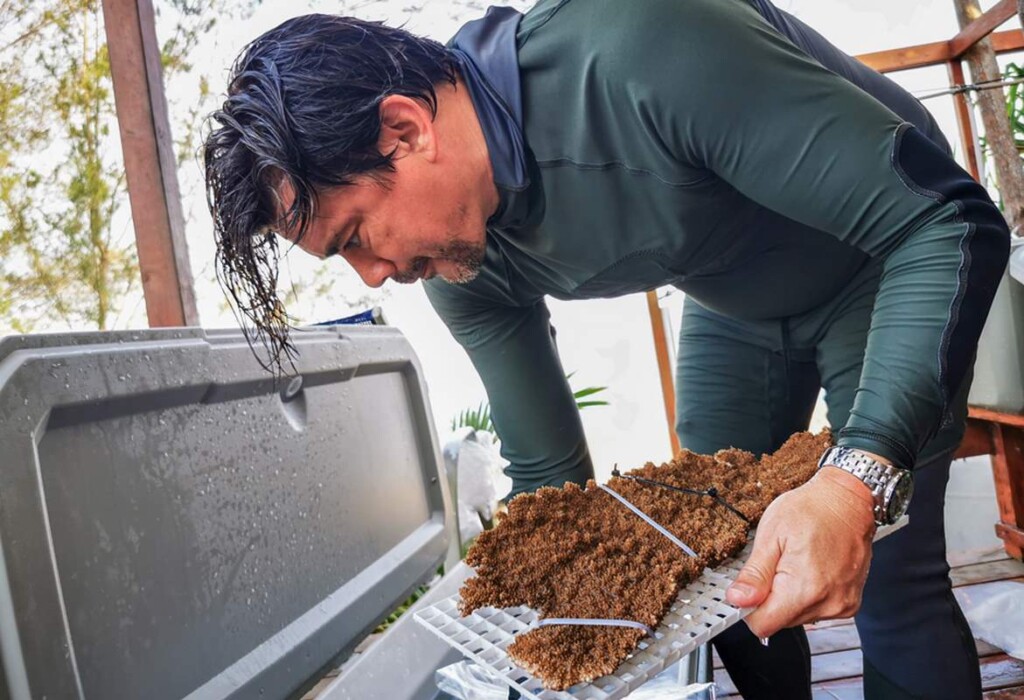
Chicken or the egg—coral or the urchin
Divers and scientists of all stripes have been down to Tela to study the reef and come up with ideas for how it’s so resilient. Several theories exist.
The first, developed by a local hotelier and diver, is that periodic flushes of very saline water from the Gulf cause mass die-offs of harmful bacteria and algae that can choke coral reefs. It’s plausible, but nearly impossible to study scientifically.
Another theory is more straightforward—fishermen avoid the reef because its richness presents small bait fish with innumerable hiding places, keeping larger species of game fish away.
A third and more exciting theory is that the coral at Tela contains a special variety of heat-resistant ‘symbionts’—the term for photophilic microorganisms that live inside coral cells and feed the coral with energy via photosynthesis.
There are many kinds of symbionts, Nat Geo claims, and coral can “shuffle” them around after stressful events. The corals of Tela may have a special symbiont that helps them cope with warmer, more acidic water.
Baker works in the Univ. of Miami’s Coral Reef Futures Lab, and the elkhorn coral samples that he and his team brought back from Honduras in the first-ever transportation of its kind are, in fact, dominated by a unique symbiont that displays heat resistance. The symbiont has been found in coral before, but never in whole reef systems.
There’s another aspect of Tela Bay that could account for the coral’s survival: the presence of long-spined sea urchins, a species that was decimated by a disease in the 1980s that saw 90% of the individuals die off. They graze on harmful algae and create spaces for coral to settle.
“It’s a real chicken and egg situation,” Dan Exton, a coral reef ecologist who has studied Tela, told Nato Geo. “What came first, the unusually high population of sea urchins or the exceptionally high abundance of corals?” he said, adding that the density of corals gives them ample space to hide and avoid predators.
DO YOU THINK THERE’S NO HOPE FOR CORAL?
- Full Recovery for Coral Reef Within 4 Years – The Speed of Restoration They Saw was ‘Incredible’
- Some Coral Species More Resilient to Climate Than Thought By ‘Remembering’ How to Survive Previous Heat Waves
- Pristine Coral Reefs Discovered Are Thousands of Years Old And Teeming With Life
- 4 Decades of Data Suggests Pacific Coral Reefs Can Acclimate to Warming Oceans and Resist Future Bleaching
- Once Devastated Pacific Reefs See Amazing Rebirth, Recovering With ‘Shocking Speed’
It’s not clear to scientists whether the answer to the riddle of Tela is one or all or some of these theories, but they’re not waiting around to find out. There’s now a coral breeding center at Tela called Tela Marine, and the proprietor hopes that genetic footprints of Tela coral will begin to make their way onto every reef in the world.
The first step has been to bring samples of elkhorn to the University of Miami’s Coral Reef Futures Lab and the Florida Aquarium in Tampa, where the two institutions will be cross-breeding native Floridian elkhorn coral with those of Tela Bay.
“This is the first time that scientists have been able to import corals from very warm reefs overseas, with the goal of trying to breed those corals with Florida’s corals, to create offspring that have increased heat tolerance,” said Baker, who has been working to understand the biology of resilient corals for more than two decades.
The breeding is already underway, and four of the 13 Honduran elkhorn have not only spawned in captivity, which itself is a very difficult process, but crossbred with Florida corals.
Keri O’Neil, director and senior scientist of the coral conservation program at the Tampa aquarium, is confident they will have spawning as well later this summer.
SHARE This Hard Work On Behalf Of An Incredible Coral Reef With Your Friends…
Postcard Finally Arrives in Swansea 121 Years After it Was First Sent–Quest to Find Descendants Begins

This postcard was slipped into a mailbox, or perhaps was supposed to be, over 100 years ago, but has only just arrived.
Dated to 1903, the Christmas-themed postcard had the address for the Swansea Building Society’s Cradock Street branch, which still exists today, and the staff there hope to find the relatives of Miss Lydia Davis, to whom it was supposed to be mailed.
According to the BBC, Ewart, the sender, was expressing to “L” his regrets that he can’t “pick up” a “pair” of an unspecified thing.
With 10 shillings “in pocket money, not counting the train fare,” he continues, “I am doing alright”.
He ends the note by urging Lydia to “remember me to (Mssrs) Gilbert and John, with love to all.”
When asked about the tardy delivery, the Royal Mail said with surprising seriousness that “when an item is in our system, we are under obligation to deliver it to the correct address.”
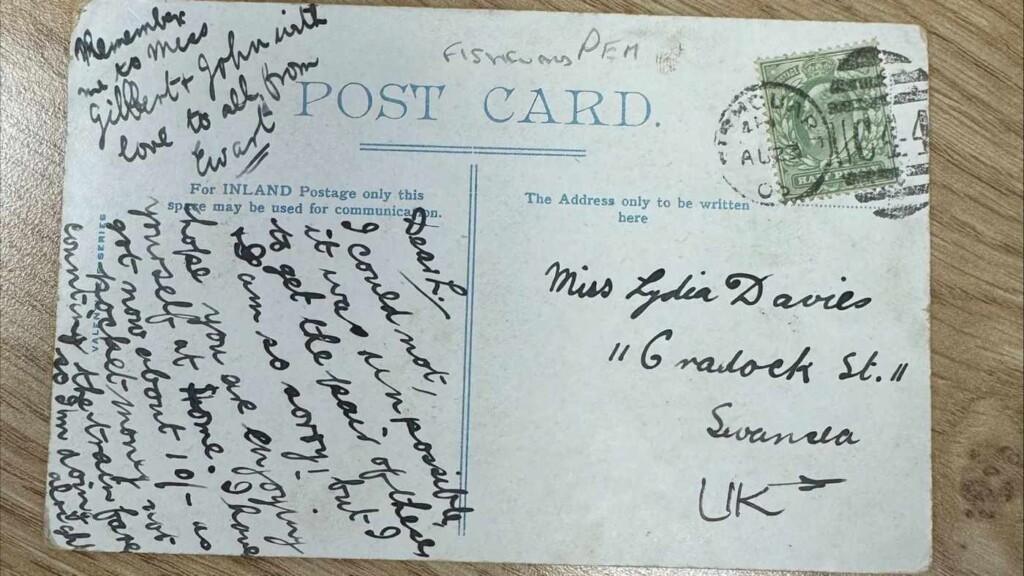
“It is likely that this postcard was put back into our system rather than being lost in the post for over a century.”
READ ALSO: My Dad Sent Me A Card on My Wedding Day–20 Years After His Death
Henry Darby, marketing and communications officer for Swansea Building Society, told the BBC that the card was delivered along with the normal mail, and that he had had no significant results in finding the relatives of “L” and the only lead they have to go on was that the rest of her family, including her father John F. Davis, had been identified. Lydia was 16 when the postcard was written.
A STORY SO SIMILAR: D-Day Hero’s Lost Postcard Finally Delivered to his Family 77 Years After Being Sent
“So we thought we’d pop it on our social media and thought maybe someone locally may be connected to her, a few generations down,” he said.
It remains to be seen what will come of the post. GNN will follow the story
SHARE This Delightful Mailbox Mystery With Your Friends…
Surprising Sophistication of the Viking Legal Code Newly Discovered in Carved Runes
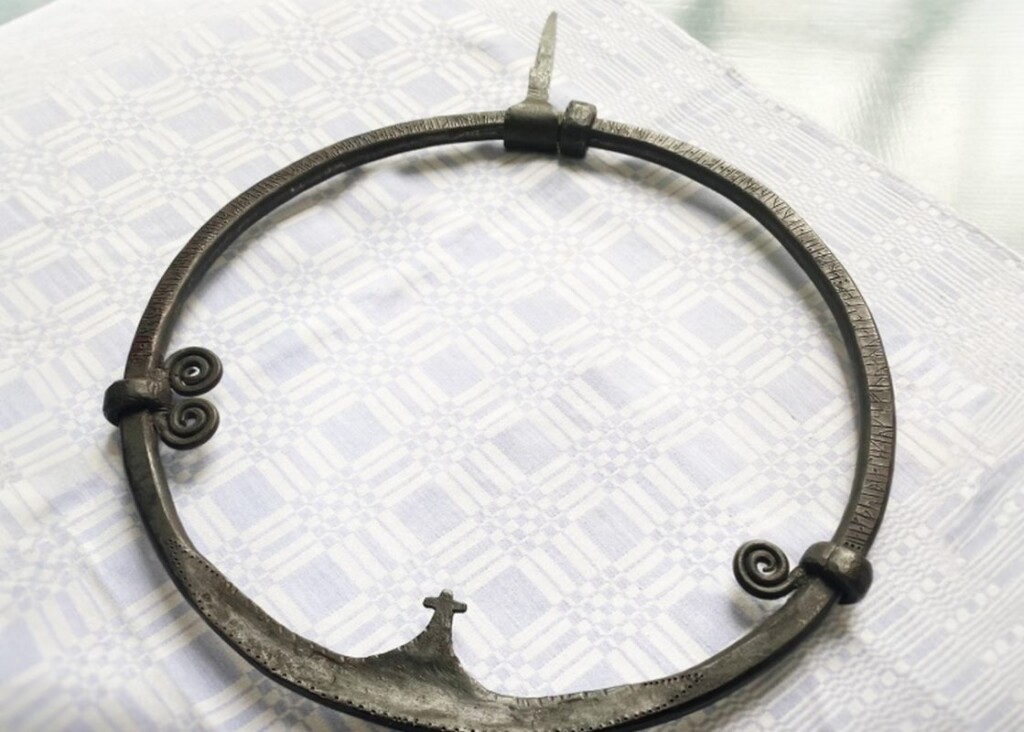
A recent reinterpretation of the oldest extant Viking legal text in Scandinavia has shed light on the surprising societal sophistication of these raiders and traders.
The text is from an iron ring found in Sweden dating to the 9th century, called the Varsa Ring
Though an undoubtedly strange place to post civic information about fines, the runic inscription emblazoned on an iron door handle was once believed to read that fines had to be paid with an ox and two öre of silver, or “uksa … auk aura tua.”
But auk has multiple meanings, one of which is “also” and Professor of Economic History at Stockholm University, Rodney Edvinsson, believes this means that fines could be paid with an ox, or two öre of silver.
Along with being a reminder that the fine print in legal speak, whether medieval or modern, should always be read carefully, the inscription’s new meaning captures the depth of societal cohesion that the often isolated and disparate communities of Scandinavia maintained, even as their members were constantly sailing off to raid or settle in other lands.
“This indicates a much more flexible system, where both oxen and silver could be used as units of payment. If a person had easier access to oxen than to silver, they could pay their fines with an ox. Conversely, if someone had silver but no oxen, they could pay with two öre of silver,” Professor Edvinsson told his university press.
A Northman who spent the majority of his time going abroad on the trade routes, or to plunder England, France, the Low Countries, or the Baltic states would find it far easier to get his hands on two öre of silver than on ox, considering his unstable lifestyle.
Indeed, tens of thousands of silver coins from all over Europe have been found at Viking trading settlements like Birka and Gotland, where, along with honestly obtained goods, those stolen from royal or monastic settlements in Europe, or from other Scandinavian kings and jarls who would certainly be wanting to recover them, could be fenced.

However, for a sedentary Scandinavian who fished or farmed, two öre of silver would be a significant quantity of money, representing months of labor, and could therefore be avoided by the payment of an oxen.
“The valuation of an ox at two öre, or 50 grams of silver, in 10th-century Sweden resembles contemporary valuations in other parts of Europe, indicating a high degree of integration and exchange between different economies,” says Rodney Edvinsson. One öre was likely equivalent to about nine Arabic dirhams, a currency that circulated in large quantities among the Vikings.
The Icelandic family sagas written in the 13th century by the legendary Norse writer Snorri Sturlsson constantly narrative scenes involving the Norse law codes that capture how these simple yet honored legal customs could resolve disputes across all the disparate Scandinavian proto-states, city-states, and communes separated even as they were by mountains, ocean, and ice.
MUST-READ STORIES ABOUT THE HISTORY OF THE VIKINGS:
- Archeologists Confirm Oldest Viking Ship Burial in All Scandinavia–Could Rewrite the Viking Age
- 4 Years After Discovery, the First Viking Ship Burial Found in Over 100 Years Reveals its Lost Secrets
- Viking Age Shipyard Uncovered at Birka is Like Nothing Ever Found Before
- ‘Sensational’ Runestone Discovered in Norway With Mysterious Inscription–May Be World’s Oldest
- While Excavating 1000-Year-old Viking Ship, Norwegians Find Remnants of Elite Society
Women had a panoply of rights above and beyond what most women in Europe at the time enjoyed. Men who committed property crimes were forced to pay for the property they took or destroyed with an equivalent from their own stock. If they couldn’t pay or refused to, the ‘Thing,’ or jury, may declare that the criminal lost legal protections on a certain amount of his property. This often led to a culture of bounty hunting, but could nevertheless quickly resolve property disputes if the criminal went to sea to try and escape justice.
Repeated criminal offenses could lead to all the man’s property being forfeited to the community, or even of the man himself being declared an exile, at which point even his murder was permitted by law—though this was rarely done if the case did not itself involve murder.
This simple recourse to community-established norms predated both the Magna Carta and therefore English Common Law, and indeed is one of the foundational legal systems of modern Europe. It served to satisfy community members’ needs for legal recourse and mediation, and could be quickly adapted to suit any community of Norsemen whether far afield or right at home.
The price mechanisms for fines fit perfectly into this paradigm of ensuring that fair compensation for anti-social behavior could be obtained reasonably quickly regardless of which profession the lawbreaker practiced.
SHARE This Must-Have Insight Into The Viking Age With Your Friends Who Love VIKINGS…
“I’d rather have roses on my table than diamonds on my neck.” – Emma Goldman
Quote of the Day: “I’d rather have roses on my table than diamonds on my neck.” – Emma Goldman
Photo by: Yuliia Dementsova
With a new inspirational quote every day, atop the perfect photo—collected and archived on our Quote of the Day page—why not bookmark GNN.org for a daily uplift?

Good News in History, August 23
Happy 73rd Birthday to DC’s own Lisa Halaby, famously known to the world as Queen Noor of Jordan. The second-generation Washingtonian married King Hussein of Jordan, becoming the queen of that country. Noor is the longest-standing board member of the International Commission on Missing Persons. As of 2023, she is president of the United World Colleges movement and an advocate of the anti-nuclear weapons proliferation campaign Global Zero. READ more about her life… (1951)
Manuka Honey Reduces Breast Cancer Cell Growth by 84% in Human Cells and Mice
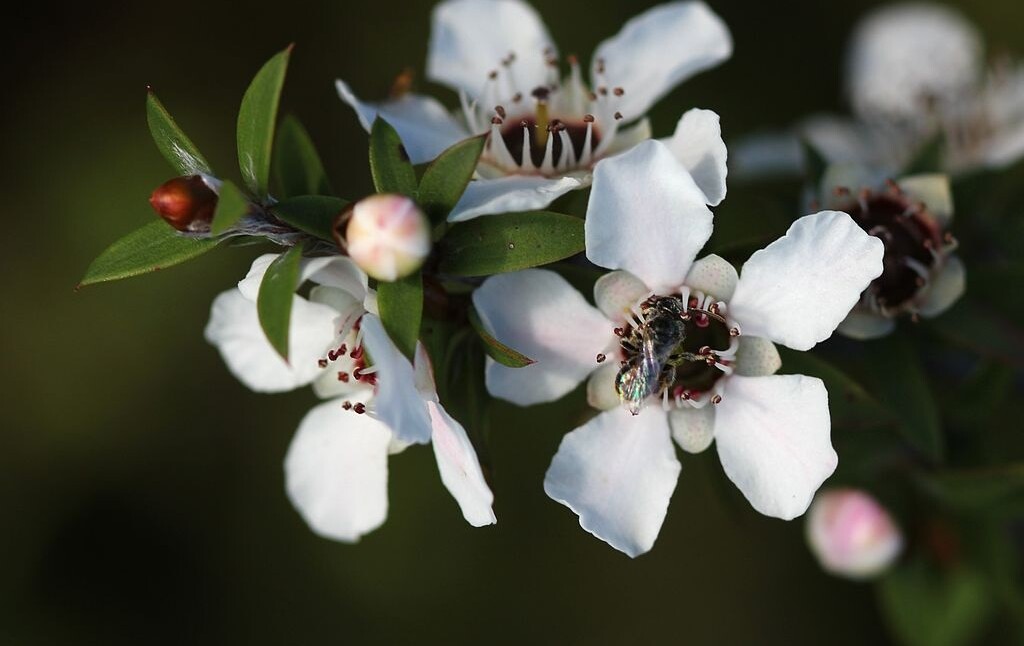
Honey has all manner of often-hidden medicine-like qualities, but more eyes will certainly be falling on Manuka honey after it was recently shown to reduce the proliferation of breast cancer cells.
It did so in a sophisticated manner that even resulted in the occasional triggering of natural cell death, or apoptosis, a mechanism that’s bypassed as a malignant cell becomes cancerous.
Manuka honey is made by bees that feed on the nectar of the manuka tree from New Zealand and coastal Australia. This member of the Myrtle family is a cousin to other plants that yield powerful medicinal products like clove, allspice, and eucalyptus.
In a study published in the journal Nutrients, investigators at the UC Los Angeles Health Jonsson Comprehensive Cancer Center found that Manuka honey significantly reduced tumor growth in mice with ER-positive breast cancer cells by 84% without affecting normal breast cells or causing major side effects.
ER-positive breast cancer makes up around 60-70% of all breast cancer cases in a given year.
It’s thought that Manuka honey is unique compared to all other commercially produced kinds of honey because of its unique chemical composition. Manuka honey has been found to be antibacterial—and not just for the bacteria a parent worries about when their child scrapes their knee—but of the kinds that cause the infections typical in cystic fibrosis patients.
“The findings provide hope for [the] development of a natural, less toxic alternative to traditional chemotherapy,” said Dr. Diana Márquez-Garbán, associate professor of medicine at UCLA, and the study’s lead author.
“Although more research is necessary to fully understand the benefits of natural compounds in cancer therapy, this study establishes a strong foundation for further exploration in this area.”
In ER-positive breast cancer, tumor cells use estrogen to grow. To combat the tumors, breast cancer patients take estrogen blockers as a non-toxic way of trying to starve them. However, cancer tumors are sometimes able to develop resistance to such treatments, leaving chemotherapy as the only alternative.
NUTRACEUTICAL NEWS: Keep Out All the Christmas Spices – They’re Powerful Antioxidants Known as ‘Nutraceuticals’
During experiments with human cancer cells in vitro, the researchers found that the best anti-cancer response was when Manuka honey was combined with the common anti-estrogen drug tamoxifen. In these circumstances, the ER-positive cell proliferation was markedly suppressed, and the combination also significantly inhibited the growth of triple-negative breast cancer, another common form, which the honey by itself could only do modestly.
In vivo experiments were then conducted in mice, during which they observed the 84% reduction in cell proliferation quoted above.
MORE MEDICINAL USES OF HONEY: Hospitals Could Use Honey and Vinegar as Antibiotic for ‘Low-Cost’ Wound Care
“These findings indicate that natural compounds such as Manuka honey, with significant antitumor activity and selectivity towards hormone receptor-positive breast cancers, may be further developed as a supplement or potential alternative to cytotoxic anticancer drugs that have more non-selective adverse effects,” the researchers concluded.
Manuka honey from New Zealand must undergo a five-stage process called the Mānuka Honey Science Definition test developed by the Ministry of Primary Industries to ensure all honey made for export is standardized to certain chemical and physical characteristics.
MORE MEDICINAL USES OF HONEY: Honey Added to Yogurt Bolsters its Bacterial Benefits–a Classic Greek Dessert Turned Medicine
This includes the presence of naturally occurring methylglyoxal, dihydroxyacetone, and leptosperin, as well as traces of the DNA of the Manuka plant. Without these, it is illegal to call a product Manuka honey. The Australian AMHA and the New Zealand UMFHA, are organizations of producers that do their part to ensure that any product labeled Manuka honey meets the standard to be called as such.
These guilds have marks of authenticity that consumers can look for to know the medicinal honey they are buying is genuine, as the amount of counterfeit Manuka honey in the market is estimated to be 6 times the amount of authentic Manuka honey.
SHARE This Amazing Discovery About The Doctor Honey…
Editor’s note: This story has been corrected from a previous version to reflect that cystic fibrosis is a genetic disorder that increases patients vulnerability to bacteria.
Rare ‘Doomsday’ Fish Surfaces in California–Just the 20th Discovered in the State Since 1901

A group of what only can be described as ‘brave’ kayakers and snorkelers saw a giant shape floating in the water ahead of them, and paddled towards it to record the sighting of an incredible species.
On a recreational paddle near La Jolla Cove, California, they had found an oarfish (Regalecus glesne)—an omen of destruction and chaos—a species of legend—and one that’s adapted to live in deeper depths in the open ocean.
Only 20 oarfish have washed up in California since 1901, according to a Facebook post from the Scripps Institution of Oceanography, and fortunately, this particular carcass was found by a group of people who work in marine sciences.
Smithsonian Institute reports that the five seagoers contacted the National Oceanic and Atmospheric Administration’s (NOAA) Fisheries Service and California Sea Grant (a collaboration between the federal government, the state of California, and California’s universities) and then enlisted the help of some passing paddleboarders as well as the lifeguards on duty to bring this 12-foot monster of the deeps to the kayak landing.
IF YOU LOVE THE DEEP OCEAN: Thar’ Be a Kraken! First Video Footage of a Possible Colossal Squid in its Own Habitat Captured
Let’s talk about this species: which may be the most interesting fish in the sea. It holds the Guinness World Record for being the longest bony fish after a specimen was seen swimming off Asbury Park, New Jersey, by a team of scientists from the Sandy Hook Marine Laboratory in 1963 estimated to measure 50 feet (15.2 meters) in length.
The longest photographed oarfish was 27 feet long, more than twice the size of this most recent one found in La Jolla Cove.
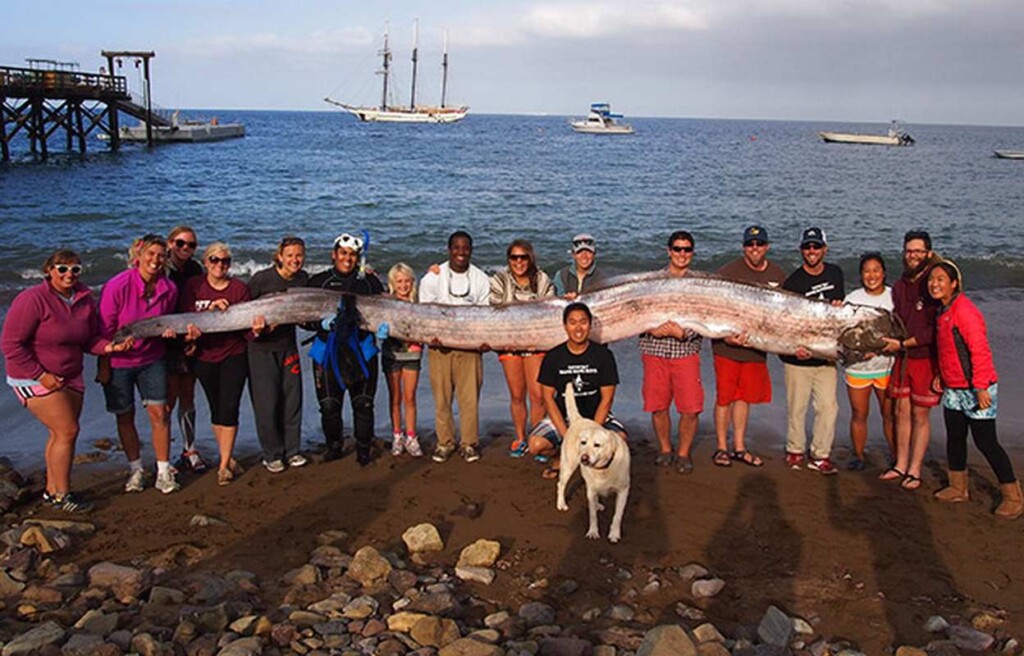
The incredible length of this animal, its tendency to spend most of its time between 700 to 3,000 feet down under, and the fact that it also occasionally comes to the surface, have led many to pinpoint it as the origin of all sea serpent mythology, as they live in all oceans apart from the poles.
Above, readers will have seen it referred to as the Doomsday Fish, a moniker that arises from Japanese mythology where its nickname is “ryugu no tsukai” which translates to “Messenger from the Sea God’s Palace”.
Sea God Ryūjin, according to a report from USA Today published last year in the wake of incredible diver footage of an oarfish off the coast of Taiwan, sends the oarfish to the surface to warn of impending earthquakes. There were sightings of the fish ahead of the 2011 Tohoku earthquake which caused the Fukushima Nuclear Disaster.
🌊 Last weekend, some lucky kayakers and snorkelers came across a rare deep-sea dwelling fish in La Jolla Cove. The seagoers spotted a 12-foot #oarfish and to give you an idea of how rare this encounter is, only 20 oarfish have washed up in California since 1901! pic.twitter.com/fDL3AWPOFq
— Scripps Institution of Oceanography (@Scripps_Ocean) August 14, 2024
The La Jolla oarfish surfaced two days before a 4.4-magnitude earthquake rattled Los Angeles.
Scientists from NOAA Southwest Fisheries Science Center and Scripps Oceanography will perform a necropsy to see if they can determine a cause of death.
MORE INCREDIBLE OCEAN WONDERS: Giant 7-foot Sunfish Found on Oregon Beach Turns Out to Be Rarest Member of the Species
After the necropsy, the specimen will find a home in the Scripps Marine Vertebrate Collection—one of the largest collections of deep-sea fish in the world—where scientists will be able to further study this mysterious species.
You’ve Got To SHARE This Incredible Animal With Your Friends Who Love The Sea…
The World’s Oldest Human Gives Us the Best Advice, Before She Dies at 117 Years

“Order, tranquility, contact with nature, emotional stability, no worries, no regrets;” might these be a string of virtues that the Stoics strove to obtain in Classical Greece and Rome?
No, not quite. They were entries in the list of all the things that have contributed to Maria Branyas Morera’s long life of 117 years of age, along with “good connection with family and friends, lots of positivity, and staying away from toxic people.”
The (how about this for a word) ondecagenarian was the oldest person alive until she passed away at her nursing home in Catalonia, Spain on August 19th, having lived to meet 11 grandchildren and 13 great-grandchildren.
Unlike many alive today, Morera saw the advent of mass communication as a positive, because it allowed her to keep in touch with people located across distances she long ago lost the ability to cover, and also share her knowledge with the world.
With the help of her daughter, she was particularly fond of taking to Twitter, now X, to share her pearls of wisdom grown over a long and prosperous life.
In many cases, these involve how she managed to live so long, which certainly never involved not taking risks or avoiding danger. Born in San Francisco, USA to immigrants from Catalonia who came over on a boat, she was 8 years old when she returned with her mother to her ancestral home where she lived ever after.
Her father died of tuberculosis contracted on the voyage to America, but his daughter survived the crossing in reverse via the Azores as a way to avoid the guns of the First World War. She survived the Spanish Civil War, the Spanish Flu, both World Wars, and briefly became the world’s oldest COVID-19 survivor when she contracted the virus at 113 years old.
On the first day of 2023, she tweeted: “Life is not eternal for anyone… At my age, a new year is a gift, a humble celebration, a new adventure, a beautiful journey, a moment of happiness. Let’s enjoy life together.”
YOU MAY ALSO LIKE: Irish Musicians Saving Oral History By Recording Elders Singing the Old Songs (Watch)
Her opnions are not all sunshine and rainbows with a glass of wine, however. For example, on July 9th, 2023, she warned that the rising rates of dementia in Western society isn’t just a challenge to public health, but to the very fabric of society.
“The great heritage of the old is the world of memory. We are our memories,” she tweeted. In an interview with the the Observer, she said that the pandemic revealed that the elderly are society’s outcast and forgotten.
MORE WISOM FROM OUR ELDERS: At 96 He May Be Britain’s Oldest Worker–And He Has No Plans to Retire: ‘You can’t sit back…Keep going’
Morera also felt that today the emphasis on money and material possessions was too great, and it worried her in general.
On August 20th, her family tweeted that she had passed away in her sleep, adding that she told them shortly before her death: “I don’t know when, but very soon this long journey will come to an end. Death will find me worn down from having lived so much, but I want it to find me smiling, free, and satisfied.”
SHARE This Elder’s Final Nuggest Of Wisdom With Your Friends Who Seem Lost…
Build Zigzag Patterns On Exterior Walls to Keep Buildings Cooler During Heat Waves

Structural engineers have discovered that if you build an apartment building with angled, shark-fin-shaped protrusions on the side where the Sun’s heat is the strongest, the angles keep the building cooler.
It’s one of a variety of simple new building and design elements being proposed for a world where July and August routinely feature stories of droughts, heat waves, and temperature records.
From the dawn of time, humans have been forced to live in hot environs. From the dawn of construction, humans have figured out how to build buildings in a way that takes advantage of thermodynamics to cool them naturally. Many of these are delightful architectural features visible in buildings from antiquity such as the Roman amphitheaters, the Taj Mahal, and the wind towers of Yazd.
Much of that planning was ignored with the advent of the modern age, and homes, whether those of the lower-middle class or the upper-middle class, took on the same character of modular boxes exposed to the mercy of any element that batters them.
In a study from Purdue and Colombia universities, researchers sought to find a simple way to retrofit boxy buildings with features that could help keep them cooler amid rising global temperatures.
One issue their research encountered is that heat hits most urban buildings from two angles—from the sun, and the ground, where cement and asphalt absorb heat and radiate it upwards all day.
SIMILAR IDEAS: This Ancient AC System will Cool your House Without Electricity
“These two directions require different properties for cool walls,” says Qilong Cheng, a postdoctoral researcher at Purdue University who worked on the study as a graduate student at Columbia University. “So we have this two-surface zigzag design, with one surface facing the sky and the other facing the ground.”
The angles, looking a little like the sawtooth roofs of factory rooms, can shave 5.5° Fahrenheit off average indoor temperatures.
Radiation coming up from the ground is reduced or deflected by one material, while heat from the sun is reflected with ultra-white paint.
OTHER INNOVATIVE COOLING METHODS: Stunning ‘House of Arches’ Uses Gorgeous Geometry to Keep Three Generations Cool in Rajasthan’s Heat
Cheng and his colleagues are now looking to patent the design and turn it into a product, perhaps made of corrugated iron which they used in their study and found could reduce HVAC energy usage by 14%.
SHARE This Quick And Easy Innovation With Your Friends…
“Love is a great beautifier.” – Louisa May Alcott
Quote of the Day: “Love is a great beautifier.” – Louisa May Alcott
Photo by: Fernando Jiménez – licensed under CC BY-SA
With a new inspirational quote every day, atop the perfect photo—collected and archived on our Quote of the Day page—why not bookmark GNN.org for a daily uplift?

Good News in History, August 22
370 years ago today, Jacob Barsimson stepped off the boat on North American soil at “New Amsterdam” (Manhattan, New York City) on a mission to discover the potential for Jewish immigration to the New World. He was followed by a party of 23 Jews that established the Congregation Shearith Israel, the oldest synagogue in the United States, and brought to the future New York City the Jewish component that has helped make it such a famous, wealthy, and diverse city. READ a little more, about Barsimson, and about Jews’ history in New York… (1654)
Stray Pup Chases a Doggie Day-Care Bus and Gets Adopted


A determined Lab has found a new home in Georgia after galloping alongside a doggie daycare bus until he won over the driver and found a new home.
In Franklin County, the story begins when the driver of the ‘pup bus’ was doing his rounds to bring clients’ dogs to daycare.
Coming to a house he knew well, a Labrador retriever who had been attending Keller Creek Boarding and Grooming for three years named Motley was waiting for the bus like normal, but this time he had a friend.
Tyson Cash, the owner of Keller Creek, contacted Motley’s owners to ask who the new arrival was, but to his double surprise, the owners said they had not adopted any new dogs.
They added, however, that a stray Lab had been in the area for a few days and neighbors were feeding and occasionally letting it stay on their property. Keller Creek is a reputable doggie daycare center, and Cash couldn’t take the risk of letting a stray onboard. So after loading Motley, he closed the door.
“I didn’t know about his vaccination status. I didn’t know if he was on flea and tick prevention,” said Cash. “I didn’t want to jeopardize all the other dogs, [but] he wanted on the bus badly. He was doing everything he could to get on with the other dogs.”
Steeling himself, he drove off, but the yellow Lab gave chase. Heart aching, Cash asked his wife to take a video and photo of the dog alongside the bus to post on social media to see if anyone in the area knew who his owners were.
A crazy dog dad through and through, Cash was pondering if there were any way he could find room in his house—filled with 9 other pooches as things stood—for this dog desperate for company. But fate, fortune, and a friendly soul stayed Cash’s hand.
Also onboard the pup bus was Nellie, another yellow Lab, whose owner saw the Facebook post and felt even worse than Cash did.
“To see a dog so desperate to catch a ride was very heartbreaking,” she told the Washington Post. “I thought, I’ve got to reach out and see if anybody has a home for this dog. If not, I want him.”
NEED MORE STORIES ABOUT DOG LOVE?
- PE Coach Pairs Unmotivated Students to Run with Shelter Dogs–Adoptions Soar
- Fateful Lunch Delivery Leads to Dog Adoption at Virginia Shelter: ‘Love at First Sight’
- When Dog Shelter Makes Appeal for Homes as Temps Plummet Below Zero People Arrive in Droves
- Abused and Stuck in Shelter for 450 Days ‘Mind-blowing’ Dog Charms Everyone at Rehab and Finds Forever Home
Ask and you shall receive. Pearce was put in contact with a woman who had been allowing the stray to stay on her property—she called him Waylon, but her two dogs were entering heat, so she had to cast him off yet again.
Pearce and her boyfriend went to bring the dog to the vet as he was in bad shape; covered in ticks and fleas, and suffering from malnourishment. They also found that Waylon had a microchip—the manufacturer of which was able to organize a transfer of ownership from the previous owners to Pearce without the latter learning anything about the former.

Now Nellie and Waylon are the best of friends, following each other everywhere, and the Pearce home has become one of joy and cuddles.
Last week, Waylon finally got his wish—a ride on the pup bus when he climbed aboard alongside his new sister much to Cash’s delight, who said it was the best ending to the story anyone could have hoped for.
SHARE This Heart-Scalding Story Of Love Finding Love…
Planting This Grass Could Yield a Bumper Crop in Flood Plains and Stop Coastal Erosion

Rising sea levels and coastal erosion are threatening farmers on America’s mid-Atlantic coast, but a crop from colonial times may be the future harvest in places like Delaware and New Jersey.
The issue is that more and more mid-Atlantic farmland is becoming inundated with salt making crops like corn and soy ungrowable, but a group of grasses colloquially known as ‘salt hay’ can not only grow in saltier fields, but has been used as fodder to give northern France’s lamb a distinctive salty flavor.
The lamb is sold as “pre-salted” because the grasses on which the lambs are grazing grow on salty marshes and plains near the coast.
A study published in Nature found that between 2011 and 2017, visible salt patches almost doubled across land along the Delmarva Peninsula, and over 20,000 acres of farmlands were converted to marsh. The range of economic losses was estimated between $39.4 million and $107.5 million annually under circumstances where farmers abandoned corn and soy altogether.
Farmers need crops that are salt tolerant if they are to continue their livelihoods, and salt hay is not an entirely forgotten option as it was farmed at scale in New Jersey as recently as 1975. However, harvesting salt hay is just too much trouble for most farmers because it grows on marshy ground where tractors and machines are liable to get stuck.
Ambrook Research, a financial and operations planning firm for farmers and agriculturalists, found that salt hay may be on the brink of a renaissance, as some farmers on the mid-Atlantic coast are working to revive the age-old crop with modern harvesting techniques, particularly because it has so many uses.
“I have documentation of salt hay harvests on our farm dating back to the 1600s,” said John Zander, whose Cohansey Meadows Farms is perched on the Delaware Bay in New Jersey. Spartina patens, the native species of what’s officially called salt meadow cordgrass, has been identified by Zander and others as being once used for building insulation, as packing material, and as an additive to concrete.
It has also been used for paper, textiles, fodder for animals, and because it’s naturally free of seeds and weeds because of its strangulating root system, as a premium mulch for flower beds.
Ambrook Research spoke to Zander who said he has been experimenting with different planting, propagation, and harvesting methods. In his father and grandfather’s day, salt hay was harvested after a deep freeze allowed light machinery to traverse the marshes, but such frosts don’t happen these days. Instead, Zander has been growing it in salt-contaminated fields inland of where the salt hay would typically grow naturally, and says it’s producing “prolifically.”
AGRICULTURE DONE BETTER:
- New Safer RNA Insecticide Can Target Only the Devastating Potato Beetles and No Other Bugs
- Insect Farm Hatches Plan for Greener Animal Feed for Chickens and Pigs
- Bird-Friendly Maple Syrup Boosts Vermont Forest Diversity and Resilience
- New AI-Powered Farming Robot Trundles About Inspecting 50 Acres of Crops per Day for Pests and Disease
- Bangladesh Farmers Digging Simple Wells Have Created an Irrigation Wonder–With Rice Overflowing
“We’re cutting it out now like basically rolls of sod,” he said. “We either cut it into plugs or leave it in bigger mats, and it can be transplanted that way.”
Scott Snell, an agronomist at the Cape May Plant Materials Center, told Ambrook that he is interested in salt hay for its secondary benefit: as an anchor to prevent coastal soil erosion.
“These salt meadow cordgrasses are natural buffers. They help to prevent runoff and erosion, so you’re capturing nutrients and reducing soil loss from wind and water erosion,” he said.
Zander agrees, saying the root system is simply impervious.
“It just really grips on. I think if we can get some of that into places where we’re having erosion problems, it might be pretty beneficial to some of these coastal farms and towns.”
SHARE This Story Of The Fascinating Farmable Grass On America’s East Coast…
Squirrels Were Struggling in a Heat Wave so She Made Them a ‘Squirrel Spa’
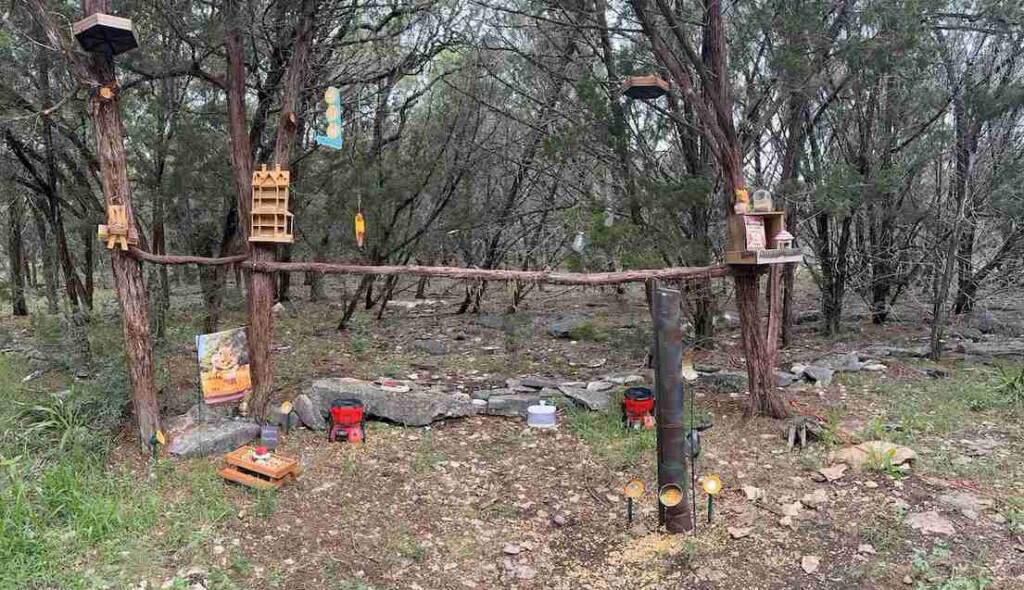
Breyana Elwell never liked rodents, but after it became clear the neighboring squirrels were suffering from the heat, she began to warm to them.
Living in New Braunfels, Texas, she maintains a sort of “squirrel resort” where the arboreal rodents can stop by, cool down, grab a bite, and lounge until the heat of the day passes.
It all started when Elwell was playing with her toddler out on the deck and the mother of two left a fan on after they were finished. A local squirrel came to realize the value of the fan and plopped himself on the railing to cool down.
There was a drought at the time, and she remembered that the animal looked full of relief, so the next morning she put new batteries in the fan and switched it on again. This time, two squirrels came to visit.
After she put a video of the rodents on her TikTok account, companies began sending her free fans to help cool more squirrels down, leading to a totally new and unforeseen hobby as far as Elwell was concerned—general management of a squirrel resort.
Building little tables and attaching them to the side of trees, squirrels can now stay outside Elwell’s house and bask in the breeze of the fans while munching on nuts, corn, and fruit frozen in ice cubes—a must in the over 100°F heat.

She placed logs between the trees to act as paths, built a courtyard for them to stay in, designed specialized feeders, bought some stylish wooden decor from the thrift stores in the area, and even hooked up a water fountain.
Every day she lugs the whole resort complex out around 50 feet from the deck and sets it all up—needing around 2 hours to finish the job. She takes it down every night to ensure the dogs that frolic around their 5-acre property don’t destroy it.
SIMILAR STORIES BUT WITH MICE: Mice Families Move into Dream Village Built By Gardener–And Are Hand Fed Flowers Every Day – LOOK
“As much as it is for them, it’s for me as well,” Elwell told the Washington Post, covering her curious hobby. She added that her sons, ages 3 and 10, love watching the squirrels. “It’s very therapeutic.”
“It can be pricey,” Elwell said. “It brings joy to me and others, so it’s just worth it. I never thought in a million years this would be something I would turn into a hobby.”
MORE STORIES LIKE THIS: Littering Scoundrel Overwhelming Neighborhood With Half-eaten Chocolate Turns Out to be a Squirrel
In general, one should never feed or care for wild animals. As soon as they learn that easier pickings are available adjacent to humans, they will abandon their wild lifestyle and instincts, largely to their own detriment. However, squirrels are not jaguars, and as anyone who has visited a city park knows, tens of thousands, perhaps hundreds of thousands of squirrels around the country already negotiate human civilization on a daily basis.
WATCH the squirrels relax for yourself…
@breeintheforest The cutest little muffins 🐿️🥜 #fyp #trend #squirrel #deer #hot #summer #viral #resort #furbaby #wholesome #kindness ♬ Somewhere Only We Know - rhianne
SHARE This Wild Story Of The Squirrel Spa In The Woods With Your Friends…
38,000 Fans Get Free CPR Training While Attending the Euro Championship–to Help Save Other Fans in Cardiac Arrest

Alongside all the other memories taken home from their stay in Germany this summer to cheer on their national team, 38,000 soccer fans are now certified in CPR.
The Get Trained, Save Lifes, campaign was a partnership between the EURO Championships and the European Resuscitation Council to raise awareness of sudden cardiac arrest and the importance of bystander CPR.
At official CPR booths, fans from all 24 participating countries practiced on manikins with sensors that measured the depth and rhythm of their compressions.
Their results were compared with other participants in the form of a computer game. Football greats like Clarence Seedorf, Javi Martinez, Ruud Gullit, and Mikel John Obi visited the booths to interact and participate in the game.
In addition to fans, the participating EURO 2024 teams have also received life-saving training at their base camps. The initiative has been extended to match officials, staff, and volunteers working at the tournament, to try and ensure that no matter where an event might occur, someone will be around who knows what to do.
The EUROS have a recent and dramatic history in raising awareness for cardiac arrest, more than the council could have ever hoped to generate on their own.
CHECK OUT THESE PASSIONATE FANS: Videos of Fans Being Awesome Flood Social Media as High Stakes European Championship Matches Draw Crowds
In the European Championships of 2020, the sporting world watched in horror as a dozen paramedics charged onto the field to try and save Denmark’s attacking midfielder.
Christian Erikson had the ball at his feet before collapsing for seemingly no reason. Simon Kjaer, the captain, ran over and determined that his colleague’s heart had stopped. In those crucial moments, Kjaer cleared Erikson’s airways before performing the first few chest compressions, alerting the tens of thousands of fans in the stadium, and the millions watching around the world, to what was happening.
CPR CAN LAST FOR HOURS: For 3 Hours Doctors Continued CPR on Toddler with No Pulse–Until Life Returned
The Danish players locked arms around their teammate to screen the view of what was happening, but the eagle-eyed television cameras still captured footage of Erikson’s limp body twitching on the ground from the compressions. The terrifying ordeal lasted several minutes before he was transported off the pitch in a medical vehicle, after which he made a full recovery.
The sporting world had had its eyes pinned open to the reality of what can be done to save a person on the very edge of oblivion, and soon, Sky Sports was welcoming paramedics onto their show to teach basic resuscitation skills.
SHARE This Great Idea To Prepare Fans With Your Friends On Social Media…
“If fear is cultivated it will become stronger, if faith is cultivated it will achieve mastery.” – John Paul Jones
Quote of the Day: “If fear is cultivated it will become stronger, if faith is cultivated it will achieve mastery.” – John Paul Jones
Photo by: Capt_tain Tom (licensed under CC BY-SA)
With a new inspirational quote every day, atop the perfect photo—collected and archived on our Quote of the Day page—why not bookmark GNN.org for a daily uplift?

Good News in History, August 21
85 years ago today, civil rights protestors quietly entered the library in Alexandria, VA to stage a sit-in. One young black man, well-dressed and polite, entered and requested a library card. When he was declined, he picked up a book, sat down, and began to read just 2 minutes before another young African American repeated the same act. This continued until five young men were silently reading at tables, and the flustered library staff called the police. READ all the other details of this lesser-known moment in the Civil Rights Movement… (1939)
Virginia Pals Save Flowers From the Landfill, Redeploying Them to Bring Joy

A pair of Virginians who found themselves habitually dismayed by the amount of floral waste they saw over a series of weddings and funerals decided to launch a small nonprofit to reuse them.
Friendly City Florals delivers flowers to hospice care homes, hospitals, and other events like funerals and weddings to make sure that the joy and special feeling a vibrant bouquet inspires can continue to do so as long as there is color in the petals.
The story begins when Rebecca Shelly, an experienced wedding industry worker, was cleaning up in the aftermath of a wedding reception in North Carolina last year, and was agonizing over stuffing hundreds of perfectly perky peonies into black garbage bags.
She saved as many as she could, but as Shelly told the Washington Post, one could have filled two U-Haul trucks with them all. This sense of regretful waste continued earlier this year, when Shelly and her friend Laura Ruth were grieving over a tragic double loss—both their fathers had passed away in the span of a few months.
The residents of Harrisonburg, Virginia, were remarking over how many bouquets of flowers had arrived at their house over the days.
“What if we could repurpose the flowers and brighten the day for somebody else?” asked Shelly, 32, who along with Ruth, launched Friendly City Florals. “We’ve put the word out everywhere that if you have too many flowers and don’t know what to do with them, we’ll take them off your hands.”
The pair now spend several days a week traveling to halls, houses, and venues to collect floral arrangements that would otherwise be thrown out. They bring them back to Shelly’s home, pick out any wilted stems, and replace them with fresher flowers before driving the bouquets out to those who need them.

“It’s a simple thing to pick out what’s wilted, add some of our own [flowers] if needed, and share the joy one more time,” said Ruth, whose own kitchen is usually spilling over with donated zinnias, daisies, and dahlias which they specialize in.
REDUCE, REUSE, RECYCLE, READ: Old Wind Turbines are Repurposed into Footbridges Capable of Supporting 30 Tons
Washington Post spoke with staff and residents of several locations Friendly City Florals frequents, including the Virginia Mennonite Retirement Community in Harrisonburg and the Bridgewater Retirement Community in Bridgewater, all of whom said the flowers were genuinely day-changing joys.
The non-profit also accepts donations from at-home gardeners, or anyone who has spare blooms to spare.
MORE STORIES LIKE THIS: Millions of Wildflowers Now Delight the Town After Vermont Couple Got Tired of Mowing the Lawn All Day
“Especially in nursing homes, that population often they’re socially isolated more often than other communities. They don’t have space for their own greenspaces, there’s just a lot of needs there. And so we found that bringing florals into them, they get visitors from it, they just have some greenery, some flowers in their room. We just hear so much feedback about how much joy it brings them and how much they love it,” Ruth told WHSV 3.
BRIGHTEN UP Someone’s Day With This Great Story Through Social Media…


























